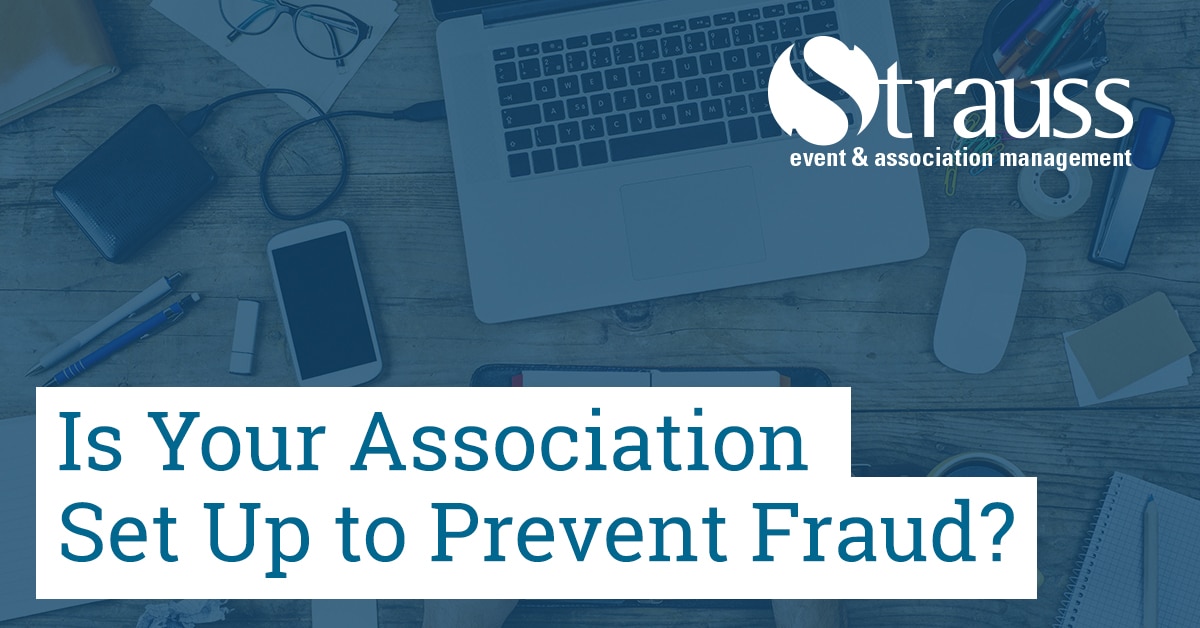It’s no secret that fraud is a large risk to any organization. There are numerous ways fraudulent activity could take place in an accounting system and it’s important to understand your risk factors and to take into consideration several things to prevent fraud in an association.
Smaller associations are more vulnerable to fraud due to many factors such an fewer staff members, less financial expertise, close relationships of staff members and fewer formal procedures in place. Fraud can also have more of an impact on a smaller association, since even a comparably minor fraud could create a large problem with cash flow or with other vital resources.
Internal Controls
Internal controls in accounting is defined as a process for ensuring achievement of an association’s objectives in operational effectiveness and efficiency, reliable financial reporting and compliance with laws, regulations and policies. The broader concept of internal controls involves everything that helps mitigate or control risks within an organization. We take these controls seriously as an association management company. These are ways that internal controls can help to reduce the risk of fraud in associations:
Segregation of Duties
Since smaller organizations generally have fewer staff, there is a greater chance that one person performs multiple duties; there may be a lack of formal oversight procedures for this reason. Segregation of duties refers to the concept of having multiple employees perform various items in a series of tasks to ensure that if someone is acting in a fraudulent way, another employee has a greater chance of noticing this activity. For example, if one person prepares a bank deposit, then another person should be bringing the deposit to the bank.
Access Controls
Restrict access to various systems using passwords, electronic access logs or various other security features offered by many software programs, websites, etc. Access controls provide a way of auditing access to the systems while ensuring that each employee has access only to information relevant to their responsibilities within the association.
Physical Audit of Assets
Physical audits include hand-counting assets. Whether it be counting inventory or cash, physical audits can reveal hidden discrepancies in account balances. Depending on the size of the inventory, physical counts are recommended to be completed either quarterly or annually.
Standardized Financial Documentation
Standardizing the process for financial documentation such as purchase orders, invoice processing and expense reports can help identify inconsistencies. Using standard formats can make it easier to review past documents when searching for the source of discrepancy.
Regular Reconciliation of Accounts
Using a system of double-entry accounting (where debits always equal credits) is a reliable way to ensure that accounts are always balanced.
Also, regularly reconciling accounts is imperative. Typically, accounts should be reconciled on a monthly basis, but if there are many transactions, more frequent reconciliations may be helpful.
Approval Authority Requirements
Having controls over who has the authority to approve transactions is important to make sure that more than one person is responsible for all transactions. Similar to segregation of duties, it’s common to have dual-signature requirements on bill payments and investment transactions.
Take Responsibility for Your own Accounting Knowledge
Depending on the size of the staff and who the volunteer board members are, there may be a lack of in-depth expertise on financial matters within the association. It’s important to do as much research as possible on financial topics to fill in any gaps in your accounting knowledge. When in doubt, ask the question!
Association leaders must be prepared to take responsibility for the financial items. These responsibilities should include regularly scrutinizing expenses and monthly bank accounts and asking questions if something looks abnormal. These days, bank accounts often include pictures of the cancelled cheques, which makes it easy to see errors. Key items to look for are missing cheque numbers and unknown payment recipients.
Directors and board members should play an active role in reviewing monthly financial statements, audited financial statements, budgets and payments. Having an informed and educated association board gives members confidence that their organization is being well-managed and ethically-run.
Fraud Detection
In addition to prevention strategies, your association should also have visible and know detection methods in place. If employees know that the company is diligently monitoring its accounts, employees will be less likely to commit fraud.
Get an Audit Done
An important role in fraud detection is getting an annual audit of the financial statements. Auditors employ numerous strategies in order to detect fraud. To read more about conducting an association audit, see our article about the difference between an audit and a review engagement here.
Those who are willing to commit fraud will not discriminate. Regardless of an association’s size, everyone is at risk. Your association can diminish its risk of fraud by having proper prevention and detection systems in place. It’s important to keep in mind that the cost of developing protocols and plans would be much less costly than if fraud was committed. Couple these crucial protocols and plans with an attentive and inquisitive association board, and your risk of fraud can be greatly diminished.

